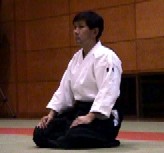Fundamental Techniques: Dai-Ikkyo

Tatsu Aikido Techniques
Table of Contents
Dai-Ikkyo
The techniques start with the Fundamental techniques. The Fundamental techniques are the Dai-Ikkyo control pinning technique, the Irimi-nage throwing technique, and the Shiho-nage throwing technique.
First, here is an explanation of the Dai-Ikkyo technique when the opponent attacks with Shomen-uchi, frontal strike. Another name for Dai-Ikkyo is Ude-Osae, arm pin. Please make sure that the Ude-Osae, arm pin, movement is incorporated into the technique while performing the technique.
Shomen-uchi Dai-Ikkyo
<Omote/front> Explanation of technique movements
Since this is a frontal strike, you start from the right hanmi oblique posture.
(Sabaki/handling) Block an incoming frontal strike with your right sword using the Ikkyo movement, using the extension of your forearm. As soon as your right sword touches the opponent’s striking arm, use the right sword to scrap-out (sweep with hand blade), Sogi-dashi, the opponent’s striking arm diagonally to the side from the line of attack. While keeping the opponent in Manaka, the center of your body, move your front foot diagonally forward to the right inside the opponent, and hit the opponent’s upper arm with your left sword.
(Kaeshi/flip-over) Instantly return the opponent’s arm using the extension of your left hand, then move your back foot forward.
(Otoshi/drop) Use your left sword to lower the opponent’s upper arm to the floor using Aiki-sage and gravity.
(Pinning) After making the opponent lie on his stomach, extend the opponent’s arm 15 degrees above both shoulder lines, straighten your back, and use the left sword to rotate the opponent’s upper arm using the extension of your forearm, and finish with gravity. At this time, place your right knee on your opponent’s wrist or forearm, and press your left knee against his side. Even if you let go of both hands, you can still control your opponent with just your knees.
(Release/finish) With your opponent’s right palm facing up, fully extend his arm, fix the upturned palm with your hand, then open your body and move away from your opponent.
Points
(Sabaki, Kaeshi, Otoshi) Always place your opponent in Manaka, the center of your body and perform the technique.
(Otoshi) You can also hold your opponent’s upper arm with your extension arm and drop his arm by simply sitting down. For beginners and white belts who are still practicing ukemi, you should step forward to perform the drop for safety.
(Pinning) You can also immobilize your opponent by placing your one of fingers on the middle finger of your opponent’s palm that is facing up.
<Ura/back> Explanation of the technique movement
Since it’s a frontal strike, you start from the right hanmi oblique posture.
(Sabaki) Block an oncoming frontal attack with the movement of the Ikkyo movement using the extension of the forearm, and as soon as you touch the opponent’s striking arm with your right hand, use a light scraping motion, Sogi-dashi, with the right hand to shift the direction of the opponent’s striking arm. At the same time, move in with your front foot to the right side of the opponent, then move forward with your back foot, placing the opponent in the center of your body, Manaka.
(Kaeshi) Return the opponent’s arm with the extension of your left hand, and
(Mawashi-otoshi) Keep the opponent’s upper arm in the center of your body, and while using the extension force to drop the opponent downwards, turn your back on your left foot and drop the opponent downwards in a spiral. The rest is the same as in the Omote.
Points
(Rotary Drop) When performing a spine roll, be aware that your body should not get ahead of you, and always keep the opponent’s upper arm in the center of your own, Manaka. Your arms should push the opponent’s arm around with your own extension force, and transfer the movement by using gravity. There is absolutely no use of your own upper arms to pull the opponent’s arm .
Cross-grip Dai-Ikkyo
The frontal strike, one of the basic attack techniques, is difficult for those learning Aikido for the first time, as they must start by learning how to strike. In such cases, we use the cross grip attack to help them understand the Ikkyo technique.
<Omote/front> Explanation of technique movements
Since it is a cross-grip attack, the start is with the right hanmi oblique posture of the body, and the opponent (Uke) uses his right hand to grab your right wrist of the right hanmi.
(Sabaki) Just before the opponent grabs your arm, turn your hand-blade up in an instant, and without your opponent realizing, grab your wrist with your hand-blade up.
(Kaeshi) Return the attack with your hand-blade first, toward your opponent’s face, using your extension force.
(Otoshi) After that, it’s the same as a front strike.
Point
(Sabaki/handling) The opponent cannot see the direction of the hand when the opponent holds the sword.
(Kaeshi/return) The maneuver of returning the hand blade to the opponent’s face is a mechanism to maintain the center, Manaka, from the moment your hand is held. This is easier than striking from the front.
Another effective action is to have the opponent hold your wrist as it is, raise the hand blade from the fingertips like in the Ikkyo movement, and then return the sword.
<Ura/back> Explanation of the technique movement
(Sabaki/Kaeshi) This is done in the same way as Omote. By moving your tegatana (shuto), hand blade, towards your opponent’s face, you can perform the technique while keeping it centered, Manaka. The rest of the procedure is the same as Ura of Shomen-uchi Ikkyo.
The above was an explanation of the Fundamental Aikido techniques, Dai-Ikkyo, using Aiki of Aikido.
Tatsu Aikido Techniques Table of Contents
Tatsu TAKAHASHI tatsuaiki7@gmail.com
